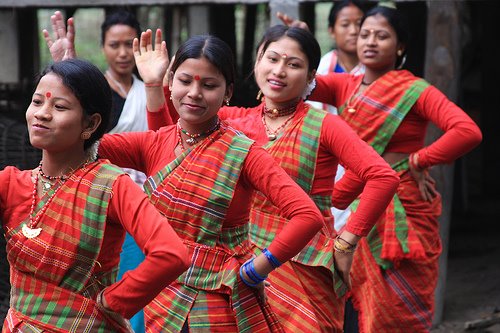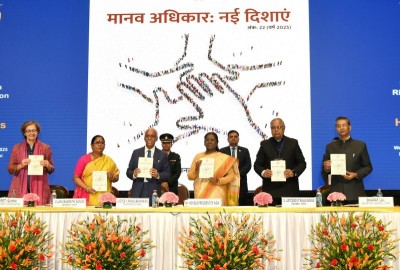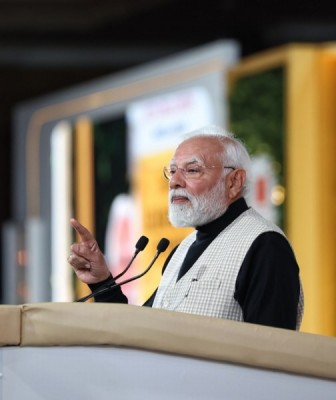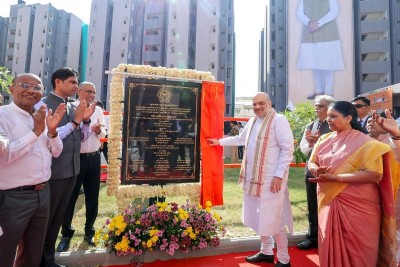
Assam: Volatile Peace
According to the South Asia Terrorism Portal (SATP) insurgency-related violence accounted for a total of 59 deaths, including 48 militants, 10 civilians and one Security Force (SF) trooper through 2015. In comparison, 2014 had recorded 305 killings, including 184 civilians, 116 militants and five SF personnel. Prior to this, the lowest insurgency-related fatalities in the State stood at 91 (55 militants, 32 civilians, four SF personnel) in 2012. At the peak of insurgency, Assam had recorded 783 fatalities (531 civilians, 180 militants, 72 SF personnel) in 1998.
In 2016, there have been just two fatalities - one civilian and a militant - in the State, till date. A cadre of the National Santhal Liberation Army (NSLA), an Adivasi (aboriginal tribal people) militant group, identified as Ram Kishku aka Ram Hembrom, was killed in an encounter with Assam Police near Grahampur under Srirampur Police outpost in the Gossaigaon Subdivision of Kokrajhar District on January 13, 2016. Earlier on January 1, 2016, in a clash that took place inside the Sudempuri Camp in Kokrajhar District, where surrendered National Democratic Front of Bodoland (NDFB) cadres have been kept, one Darendra Basumatary was killed and another militant, Aninda, was injured, when the accused, Rakesh Brahma, opened fire at them after a fight. Police subsequently arrested Rakesh Brahma along with his weapon. The trio had surrendered in 2006.
Crucially, the number of civilians killed through 2015 (at 10) was the lowest since 1992. Earlier, the lowest figure in this category was 32 in 2012. The civilian population in the State thus appears to be more secure than it has been for nearly a quarter of a century - the single most significant achievement of the year.
Similarly, with just one SF trooper killed in 2015, this was also the lowest SF fatality since 1992. In 2014, SF fatalities stood at five; the highest number of SF fatalities were recorded way back in 1996, when 87 personnel had been killed fighting the insurgents.
48 militants were killed through 2015, as against 116 through 2014. The fall in this category coincided with overall decline in total fatalities, and can mainly be ascribed to the fact the SF operations have forced the militants to scale down their activities in the State, even as the progressive splintering of the principal militant formations has undermined their operational capacities. Significantly, 2015 saw the best SF/militant kill ratio recorded in the State, at 1:48. At the peak of insurgency, in 1996, the ratio stood at 1:0.7.
Most militant formations operating in Assam continued to suffer losses in 2015. Of the 48 militants killed, the I.K. Songbijit faction of the NDFB (NDFB-IKS) lost the largest number in clashes with SFs, 23; followed by Karbi People's Liberation Tigers (KPLT), 11; the Action faction of Dima Halim Daogah (DHD-A), two; Jabinkhe Naiso Boshom (JNB), two; the Original faction of the United Democratic Liberation Front (UDLF-O), two. One cadre each of the Independent faction of the United Liberation Front of Asom (ULFA-I), Garo National Liberation Army (GNLA), Kamtapur Liberation Organization (KLO), Dima Hasao National Army (DHNA) and United Peoples Liberation Front (UPLF) were also killed. Group affiliation of the remaining three militants killed was not specified. The prominent militants killed included, DHD-A 'chairman and commander-in-chief', Sibu Kemprai and a founding member of the group, Nigam Phonglo. Of 10 civilian killings, ULFA-I was responsible for five and NDFB-IKS for two. The remaining three killings in this category remained unattributed. NDFB-IKS was responsible for the lone SF killing in 2015.
SFs arrested 602 militants of different outfits during 2015. These included 234 belonging to NDFB-IKS; followed by KPLT, 58; ULFA-I, 37; NSLA, 22; Jama'atul Mujahideen Bangladesh (JMB), 20; Muslim Tiger Force of Assam (MTFA), 19; CPI-Maoist, 19; GNLA, 18; United People's Liberation Army (UPLA), 11; and Muslim United Liberation Tigers of Assam (MULTA), 10. 405 militants had been arrested through 2014.
On August 14, 2015, SFs arrested 12 KPLT militants, including its self-styled 'chairman' Sarmung Timung, from the forested area of East Karbi Anglong in Karbi Anglong District. After the operation, Defence Public Relations Officer (PRO), Lieutenant Colonel Suneet Newton stated, "This operation has practically put an end to KPLT in East Karbi Anglong."
Similarly, following the killing of the NSLA militant in the January 13, 2016, encounter in Kokrajhar District, Bodoland Territorial Council (BTC) Inspector General of Police (IGP), L.R. Bishnoi asserted that, with the elimination of NSLA militant Ram Hembrom, the area would be peaceful to a great extent, as most disruptive activities were carried out under his command. He said the total strength of the NSLA was around 40, of which 22 were arrested in 2015, four were killed in different encounters and the remaining cadres were involved in criminal activities.
Notably, SFs had launched 'Operation All Out' to flush out militants after the NDFB-IKS militants massacred over 69 Adivasis on December 23, 2014. The operation, in which Indian Air Force, Army, Paramilitary Forces and State Police work together, is still on.
Meanwhile, other parameters of violence, including major incidents, Districts affected by violence, killing of non-locals, etc., recorded sharp declines as well.
As against 18 major incidents (each involving three or more fatalities) resulting in 181 deaths recorded in 2014, 2015 saw just two such incidents, accounting for six deaths. Further, the number of Districts from where the fatalities were reported stood at 13 in 2015 as compared to 19 in 2014, out of a total of 32 Districts in the State (including five new Districts created in 2015; Biswanath Chariali, Hojai, West Karbi Anglong, Charaideu and South Salmara-Mankachar). The Districts from where killings were reported in 2015 were Karbi Anglong (12), Kokrajhar (12), Dima Hasao (9), Chirang (6), Sonitpur (5), Dhubri (2), Karimganj (2), Sivasagar (2), Tinsukia (2), Udalguri (2), Darrang (1), Goalpara (1), and Lakhimpur (1). In 2015, five non-locals were killed as against eight such deaths recorded in 2014. However, the number of attacks on non-locals increased from three in 2014 to four in 2015. ULFA-I was responsible for all the four attacks against non-locals in 2015. No such attacks had been reported through 2012 and 2013. Also, the number of explosions decreased from 20 in 2014 to just six in 2015, and resultant fatalities reduced from eight in 2014 to two in 2015.
Reported incidents of abduction and extortion by militants also fell during the year 2015. According to Assam Police records, there were 5,192 cases of abductions registered in the State in 2015 (data till October); as against 5,378 cases in 2014. The data further shows that there were 1,157 extortion-related cases registered in 2015 (data till October); as against 1,357 in 2014. Though most of the abductions were carried out by criminals, the Home Department records did not rule out the role of militant outfits of the region in some of the incidents.
The process of talks with some militants group also continued through 2015. In amajor development, on November 11, 2015, Bangladesh handed over the 'general secretary' of the undivided ULFA, Golap Baruah aka Anup Chetia, and two of his prison mates who were arrested along with him in Bangladesh in 1997, to Indian Security Agencies. Soon thereafter, Chetia was brought to India, and was placed under arrest in connection with various cases of extortion, abduction, murder and attempt to murder. He was released on bail on December 24, 2015, and has made a commitment to participate in ongoing talks between ULFA-I and the Government. Seven leaders of the Pro-Talks faction of the United Liberation Front of Asom (ULFA-PTF), including Anup Chetia and 'chairman' Arabinda Rajkhowa, met interlocutor P.C. Haldar at the Border Security Force (BSF) camp in Patgaon in Guwahati on January 21, 2016, and discussed issues concerning the ongoing talks with the Centre. After the meeting, Rajkhowa said that Chetia's inclusion would give a fresh impetus to the talks and a solution would soon be worked out with the Government.
13 militant groups are currently under Suspension of Operations (SoO) agreements with the Government, and another four groups - Bodo Liberation Tigers (BLT), United People's Democratic Solidarity (UPDS), Dilip Nunisa faction of Dima Halim Daogah (DHD-N) and Jewel Garlosa faction of DHD (DHD-J) - have signed Memorandum of Settlement (MoS) agreements with the Government. However, no new SoOs or MoSs were signed in 2015.
Despite these broad gains, the State continues to face challenges from various insurgent groups. Then Director General of Police (DGP) Khagen Sarma in his farewell speech on November 30, 2015, observed,
Militancy might be on the decline in the State but it was far from over. Though agreements have been signed with four militant groups and 13 others are in talks with the Government, some breakaway factions of these groups, which are yet to join the peace process, remain a worry for the security forces.
Again, on December 26, 2015, he had noted "Assam has religious fundamentalists and that has generated a lot of interest in the ISIS. Hits in the Internet photos of ISIS are very high in Assam."
Raising similar concerns, the new DGP of Assam, Mukesh Sahay, stated on November 30, 2015,
We cannot lower our guards or sit back and relax. Militancy can rise from the ashes and we have to come up to meet the challenges. Militancy may have declined but it has the potential to reignite. We have to be constantly on alert and formulate our response to any situation.
Echoing these views, Assam Chief Minister Tarun Gogoi observed, on November 6, 2015, "Islamic outfits, Maoists and all other insurgent organizations are trying to create trouble in the State, but we are vigilant, containing insurgency is the single-most (important) achievement of my three terms in office but there are several forces trying to destabilise the State and its development."
Indeed, State Parliamentary Affairs Minister Rockybul Hussain on December 8, 2015, had informed the State Assembly, that eight militant groups - ULFA-I, NDFB-IKS, KPLT, KLO, CPI-Maoist, MULTA, JMB and Harkat-ul-Mujahideen (HuM) - were presently active in Assam. Among these, NDFB-IKS and ULFA-I dominated insurgent activities in the State in 2015.
Reports also indicate that ULFA-I, NDFB-IKS, KLO and the Khaplang faction of the National Socialist Council of Nagaland (NSCN-K) had jointly formed the United National Liberation Front of Western South East Asia (UNLFWSEA), a common front of militant groups in India's Northeast region. Different ethnic armed groups (EAGs) continued with efforts to engage in disruptive activities and had formed this united platform - UNLFWSEA; they were also developing a nexus with transnational jihadi groups and Maoists, increasing the threat potential in the State.
The entrenched dangers of Islamist terrorism continued to haunt the State through 2015. According to a May 21, 2015, report, a JMB militant, Lal Mohammed akaIbrahim, who was arrested on April 18, 2015, by Jharkhand Police, revealed to his interrogators that his group's sabotage plans in Assam were intended to counter Bodo aggression. According to a report dated, September 20, 2015, the Guwahati Police also warned that some Islamic terror groups had started recruiting Muslim youth in the Bodoland Districts of Chirang, Kokrajhar and Baksa, with the intention of triggering fresh violence during the run-up to the 2016 State Assembly elections. Notably, two modules of JMB detected in the State were in the Barpeta and Nalbari Districts, situated close to the Bodoland Territorial Area Districts (BTAD). The JMB modules were exposed in the countrywide crackdown in the aftermath of the October 2, 2014Burdwan blasts.
Worryingly, on September 16, 2015, Police and Central Reserve Police Force (CRPF) neutralized a jihadi training camp and arrested three suspected extremists, identified as Minarul Islam, Bodiul Zamal Sekh, and Zohorul Haque from the Daukhanagar area under the Dhaligaon Police Station of Chirang District. According to the Police, at least nine persons from Barpeta, Bongaigaon, Baksa, Nalbari and Kokrajhar were undergoing training at the residence of a man identified as Iman Ali. Subsequently, on September 18, 2015, Police recovered eight handmade AK Rifles and two handmade INSAS Rifles from the backyard of the house of another person, Mohammad Sayed Mia, allegedly associated with the training camp. Though exact information about the group behind the training camp is yet to come to light, unconfirmed sources from the Police disclosed that the Islamic extremist MULTA was the brain behind the training camp. Intelligence Bureau (IB) reports also suggest that JMB uses MULTA as the umbrella organization of various jihadi elements in Assam to carry out organizational activities, including collecting money, and imparting basic motivation and training to youth who are willing to join.
Further, according to an October, 8, 2015, report, the Maoists continue to struggle to gain a foothold in the Northeast and they are tapping a 'wide' range of allies', including rhino poachers in Kaziranga and the major militant groups operating in the region, including the Isak-Muivah faction of NSCN (NSCN-IM). Another report published on October 20, 2015, claimed that the Maoists were making fresh recruitments, particularly targeting youth aged 12 years and above, as they were running short of manpower in Assam. The seven Upper Assam Districts of Dhemaji, Jorhat, Lakhimpur, Dibrugarh, Tinsukia, Sivasagar and Golaghat, with Districts bordering the neighbouring Hill States, are believed to be vulnerable to Maoist mobilization, while the belt along the Brahmaputra River is also thought to be susceptible. Though arms' training of recruits is largely located outside Assam, political mobilization imparted to them in Upper Assam itself.
While the Central Forces with the help of the State Police have succeeded in minimizing the threat from insurgency, neutralizing the remaining challenges to establish a lasting peace will require a significant strengthening of the State Police Forces, as well as concerted efforts on the developmental and administration fronts. The Assam Government has introduced the Centre's 'SMART [Strict and Sensitive, Modern and Mobile, Alert and Accountable, Reliable and Responsive, Techno savvy and Trained] Police' initiative, to make the Police more responsive, tech savvy, physically fit, alert with a modern outlook and scientific temper. However, manpower in the Police Force continues to remain low. According to Assam Police records, 12,805 posts out of the 64,988 sanctioned posts in the Police Department are vacant. This included 26 posts of Indian Police Service (IPS) out of total 135 sanctioned. The Assam Police Department issued an official notification for recruitment to 2,564 posts in various categories in December 2015.
Though levels of violence have come down considerably, extremist undercurrents and the nexus between ethnic militants, Islamic jihadists and Maoists create enduring vulnerabilities. The presence of pan-Islamist terrorist networks, combined with the porous border with Bangladesh, and Maoist ambitions in the region, add fuel to ongoing ethnic insurgencies in the region. Former DGP Khagen Sarma noted that "ethnic and other militants come and immediately unleash their violence. Religious fundamentalists prepare and take a long time to commit crime." It is within this context of both immediate and long term threats that the State must fashion its policies and align its capacities of response.
Support Our Journalism
We cannot do without you.. your contribution supports unbiased journalism
IBNS is not driven by any ism- not wokeism, not racism, not skewed secularism, not hyper right-wing or left liberal ideals, nor by any hardline religious beliefs or hyper nationalism. We want to serve you good old objective news, as they are. We do not judge or preach. We let people decide for themselves. We only try to present factual and well-sourced news.







